A paper presented at the 15th annual colloquium of the Board Game Studies Association, Munich, 2012
Hover over images to see captions
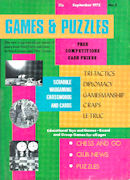
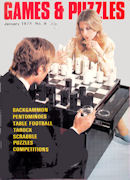
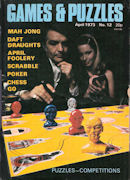
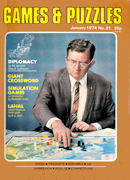
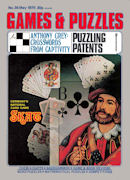
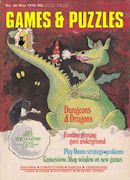
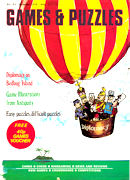
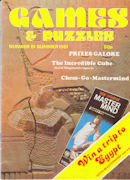
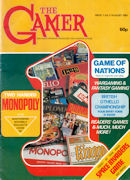
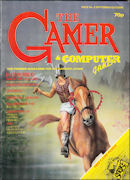
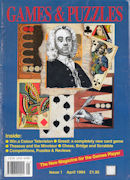
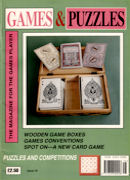
"The appearance of Games & Puzzles marks the beginning of a novel and exciting publishing venture. There has never been a magazine devoted to the games people play, the ways in which, they play them, the reasons why they play them, the people who develop them, and even the people who spoil them… It's important too. Important because games themselves are important as so many people, from teachers and psychiatrists to youth club leaders and amateur crossword fanatics, are coming to realise…Above all games are fun. And Games & Puzzles aims above all to provide fun. It is going to be comprehensive, it is going to be authoritative, at times it is even going to be quite learned, but hopefully it will always remain enjoyable from front-cover to back page." - Editorial, Games & Puzzles No.1
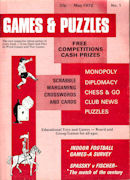
The first issue
In 1972 I was a 33-year old technical journalist for a PR company in Blackheath, South London. There, during my lunch break
on a sunny day in May, I spotted in a local newsagent a magazine called Games & Puzzles, which was not only unknown
to me but proved, on examination, to be the very first issue (left).
As a lifelong enthusiast for playing and inventing games it was just what I had
been waiting for. Better still, it contained an invitation to contact the editor if you would like to write for it, or to join a
games-testing panel. So I did, and was eventually invited to meet Graeme Levin, its founder and editor at his office at 11
Tottenham Court Road - "entrance through Reed's Employment Agency".
Reed's Employment Bureau occupied the ground floor of a shop situated in the lower reaches of Tottenham Court Road, a short distance from the British Museum. That parade of shops has long since been replaced by an array of glass-fronted eyesores (right), and No. 11 itself today houses, appropriately enough, a branch of Specsavers. You walked through a large, bright office occupied by busy- looking typists, and at the far end entered an even larger but dark and dusty storeroom lined with boxes of games and magazines. Here in the middle, like a spider in his web, sat Graeme at a second-hand desk; and you immediately perceived with some regret that the young ladies who had just delighted your eye were not the teeming editorial staff of Games & Puzzles but merely humble employees of Reed's Employment Bureau.
We discussed matters of mutual interest, one being that I should write a series of articles on Golomb's Game of Pentominoes, which was then my consuming interest. It would be a cliché to describe this as a turning-point in my life; but sometimes clichés speak nothing but the truth.
Graeme Levin was a merchant banker before moving with his family from Johannesburg to London in the early seventies. He had invented a stock-market board game called Speculate, published by Waddingtons in 1972, and in February of that year a Diplomacy fanzine called Albion reported his proposal to launch a professional games magazine. Eric Solomon tells me that Graeme approached him at the Board Games Club in London, a sub-club of Inter-Varsity Club (a social organisation for graduates). He asked Eric if he thought there was a future for a magazine about games, to which Eric opined that there probably was. The magazine first appeared in May, and was, in Graeme's words "started with no money at all". It was in fact funded by receiving 90 days' credit from the printers, 30 days advance payment by the distributors, and advance subscriptions of up to three years. Graeme had absolutely no prior knowledge about printing or publishing. "The main assets of Games & Puzzles", he reflects, "were Youthful Courage and Team Enthusiasm".
GP1 kicked off - literally - with a survey of Indoor Soccer games by someone described as "one of ITV's leading sports commentators" - an astutely populist way of appealing to as many potential readers as possible. There followed articles on Racing Demon, Chess, Scrabble, Go, miniature warfare, Diplomacy, and Monopoly, the latter written by Graeme under his pen-name "Michael Graham". Eric Solomon provided the first in a series of "Readers' Games" by describing his own (unpublished) game Fighting Sail. Additional contents included the puzzles section, readers' letters, a survey of the club scene, and alarmingly few advertisements, though they included such giants as Waddingtons, Spears, and Hamleys, London's biggest retail toy and game store.
It was a promising start, let down only by some sub-standard graphic design, which it never did succeed in transcending. There were also production difficulties: by the end of 1972 an editorial apologised for textual mistakes and distribution problems. Issues 5 and 12 are, according to BoardGameGeek, "legendary" in that very few survive, having been affected by mistakes at the printers. Only about a third of the usual print-run appeared, just enough to meet subscribers' needs; none were available over the counter. Its first year saw Games & Puzzles expand from 32 to 36 pages, soon after to 40, while retaining its original cover price of 20p. Its first full-colour front cover appeared in January 1973.
Graeme's preliminary networking amongst games writers, journalists and enthusiasts assured him of a reliable body of potential contributors. Here is a run-down of the principal editors, contributors and consultants throughout the life of Games & Puzzles - "all the usual suspects":
- Graeme Levin(1944-), founder and first editor. Founder and currently CEO of the Gambling City Network of gambling portals.
- David Pritchard (1919-2005), Chess expert and journalist, author of (amongst many other titles) The Encyclopaedia of Chess Variants; longest-serving editor and one of the magazine's chief contributors. Pen-names: David Patrick, "Sherlock", "Greco", "Blot".
- Darryl Francis (1948-), renowned word-gamer and Scrabble expert, still active; puzzles editor 1972-5.
- Dr Eric Solomon (1935-2020), mathematician, writer of engineering software, games inventor and croquet champion; also a major reviewer and contributor.
- David Parlett (1939-), games inventor, card games specialist; editor 1975; puzzles editor 1977-8. Pen-names: L Sidd, Ted Franklin, P R Jackson, "Plato".
- David Wells (1940-), maths tutor, author and puzzle composer; puzzles editor 1975-77.
- Steve Jackson (1951-), biology graduate; fantasy games specialist. Co-founder of Games Workshop. Now teaches video game design at Brunel University.
- Albie Fiore (1946-2009) Assistant editor March 1975, editor January 1977 - February 1978; left to join Steve Jackson at Games Workshop. Later compiled cryptic crosswords for the Guardian newspaper under the name 'Taupi'.
- Richard Sharp (1942-2003), expert at Chess, Bridge, Scrabble, but chiefly Diplomacy, having won the 1974 European Diplomacy Championship; a prominent member of the team throughout.
- Gyles Brandreth (1948-) eccentric polymath and games freak. European Monopoly Champion, founder of British National Scrabble Championships and of a national Teddy Bear Museum. Member of parliament 1992-7.

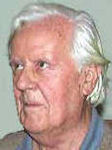








Top: Graeme, Pritchard, Francis, Solomon, Parlett
Below: Jackson, Fiore, Sharp, Brandreth
Occasional contributions emanated from such big names as R C Bell, English chess master Leonard Barden, the philosopher and Tarot historian Professor Sir Michael Dummett, recreational mathematician Robert Abbott (now strongly into mazes) and, perhaps most notably, Sid Sackson, who was listed as a permanent consultant from an early issue onwards.
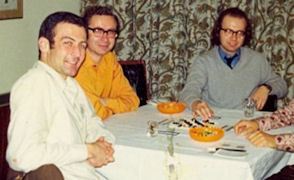
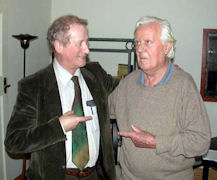
(left) Graeme, David Wells & Darryl Francis games testing c.1973
(right) Davids Parlett & Pritchard, often confused (2005)
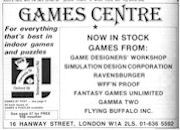
Advertising the Games Centre
Games & Puzzles was not the only games-related activity that Graeme pursued.
From issue GP13 on we find advertisements
for The Games Guild, from which you could buy games by post - nearly 500 titles were on offer. In 1975, he opened The Games
Centre, Britain's first specialist retail games shop, just round the corner at No. 16 Hanway Street.
(Which looks the same as ever
today, except that number 16 is now a Korean restaurant.)
In 1972, besides launching the magazine, he formed the British Diplomacy Club "to co-ordinate all postal Diplomacy games throughout the United Kingdom and promote the playing of Diplomacy", and also initiated the National Games Club. David Wells helped him run it for several months - "It met every Sunday in a large room of a hotel in Tottenham Court Road", he recollects - after which it was run by Richard Sharp. Stephen Agar writes: "Graeme and to a lesser extent Richard both invested some of the money to get the club started, so it was in effect owned by them. Consequently, the British Diplomacy Club was subsumed into the NGC postal games section. In December 1973 Richard Sharp announced that Graeme Levin had relinquished his holding in the NGC, leaving Richard in sole control. Graeme was thus free to devote his attention to Games & Puzzles."
An inventor himself (though the only known game of his, apart from Waddington's Speculate was his self-published Card Cricket), he advertised a games assessment service for budding inventors and acted as an agent for placing games and game books with publishers. Indeed, he was responsible for placing Hare & Tortoise with Intellect Games and the first of my card-game books, those for the Teach Yourself series.
Games & Puzzles offered unrivalled variety both in the range of games covered and in the ways it approached them. In fact, I've never seen another games magazine like it.
From the outset, it concentrated as much on traditional as proprietary games. Every issue usually covered Chess, Go, Backgammon, card games, pub games, miniature wargaming, Scrabble and Diplomacy, and, in later years, fantasy and sci-if games. The latest proprietary games were covered in "Gamesview" and usually followed up in separate feature articles. As for variety in approach, we particularly sought different ways of getting readers involved to ensure that there would be something for everyone, no matter how obscure or offbeat.
In "Playroom", for example, readers could post ideas for games they had invented, variations on existing games, questions and suggestions about rules, and tips on strategy and tactics. A series entitled "Great Games that Never Made it" speaks for itself, while another entitled "Readers' Game"s hosted some 34 contributions ranging from Archimedes to Zug, running en route through Sheep Dip.
News and views about the games scene were provided, from issues 3 to 19, by Gyles Brandreth's column "Pieces and Bits". In 1976 I started a series entitled "Across the Board" and compiled it under the pen-name 'Plato'. In one of the earliest (April 1977) I recounted how Graeme and I had visited the Nürnberg Toy Fair for the first time and enjoyed being guests at Tom Werneck's first ever Journalistentreff (a social for game-interested journalists. It may have been the second, not the first; the whole series came to an end about ten years later).
Amongst numerous "think pieces" may be cited one on Why People play Games, by a research psychologist; Why Women Don't Play Games, by a woman; Confessions of a Games Hater, by a games hater; and Robert Abbott's essay "Under the Strategy Tree", in which he expatiated upon the concepts of game depth and clarity. My prize for the best title for a feature article goes to R C Bell for his wonderful piece of word-play "From Ur to Us". And in March 1975 we ran Willard Allphin's controversial article "Who Invented Monopoly?", prompted by the legal dispute between General Mills, the then owner of the Monopoly trademark, and Ralph Anspach, the inventor of Anti-Monopoly published in 1974.
A particularly unusual but fascinating series was provided by "Bernard Kew" (Barry Quest), a patent agent who wrote occasional articles about unusual patents in the field of games and puzzles and offered would-be games inventors valuable advice on the subject.
Readers' letters ranged from straight requests for information to deep analyses of abstract games and strong disagreements with our critical reviews, especially from piqued inventors.

Mike Atkinson: Rules of the game
Humour was ever-present. Gyles Brandreth's "Pieces and Bits" were always (deliberately) good for a laugh. "Across the Board"
included, besides genuine news items, spoof items, jokes and parodies. A running gag was its inability to master the name of
Bob Abbott's game
Epaminondas, which usually emerged as
Upon my Pandas. Then there was Richard Sharp's
"Tales from Bedbug Island", which
for a run of 18 issues chronicled the experiences of a band of eccentric game-players shipwrecked on a desert island.

Mike Atkinson: Who's that at
the war-games counter?
Cartoons were provided by freelance cartoonist Mike Atkinson. Albie Fiore, under the pen-name Taupi, provided a series of
strip cartoons entitled Hare & Tortoise, revealing what they got up to when not chasing each other round the board.
We learned that Tortoise's favourite game is Speed Circuit, and that they play Mastermind using button
mushrooms on a slice of Gruyère cheese.
The Puzzles section was edited by Darryl Francis, then David Wells, then by me under the pen-name "P R Jackson", and finally by Trevor Truran. We also ran regular competitions which generated a remarkable number of entries. Graeme once commented that the volume of entries he received so outweighed the volume of games correspondence that he wondered if anyone read the rest of the magazine!
I think the three most important contributions to the games world made by Games & Puzzles were:
1. Gamesview. The games review pages represented the first time in British journalism that table games were taken seriously enough to critique. The test panel met every Tuesday evening in Graeme's office and usually consisted of some half dozen players drawn from a regular panel of up to two dozen. The first Gamesview appeared in October 1972 with reviews of Nile, Anzio, and Graeme's game of Speculate reviewed by David Pritchard.
The review format remained virtually unchanged throughout. It started with basic information about the type of game, number of players and so on. Later it would include the inventor's name, but in those unenlightened days publishers themselves did not credit inventors so we only knew who it was if it happened to be one of us. Following the tester's review of the playing experience came a box of numerical ratings for significant properties of the game.
Gamesview also included book reviews. One of the earliest was David Pritchard's review of Kawabata's novella The Master of Go (1972), a fictionalised account of the Honinbo Title Match of 1938. I was fascinated to learn that David had himself attended the event as a reporter.
2. Promoting inventors. The subject of games design and invention as a cultural activity akin to an art form was never far from our collective consciousness. The editorial of GP15 (July 1973) quotes with approval Sid Sackson's view that "A game is a work of art as worthy of being signed as a painting, a book, or a musical composition … the inventor should have the right, and the obligation, to sign his work." But it was not until GP33 (February 75) that enough manufacturers started crediting inventors to enable Gamesview to include this information as a matter of course. The first credit was to Sid Sackson for Executive Decision. GP53 (October 74) sees the first advertisement for the Graeme Levin's Games Assessment Service. In GP56 (January 77) Eric Solomon wrote an article entitled 'How I invent games', and in GP64 Tom Werneck, in "Diary of a Disaster", recounts an embarrassing moment that also appears in his 1987 book Leitfaden für Spieleerfinder, so I needn't repeat it here. Then in GP58 (March 77), under the title "But is it art?", Paul Morphine considers games design as one of the fine arts. Several inventors, at various times, took the opportunity of writing about their approaches and experiences.
3. Game of the Year Award. In 1975 Games & Puzzles founded a Game of the Year award, to take the form of a plaque to be presented by Games & Puzzles and Toys International. Readers were invited to list their three favourite games in order of preference. Each game would received 3 points for each 1st place nomination, 2 for each 2nd, and 1 for 3rd place. The response, published in GP43 (December 1975), was described as "astounding. No fewer than 91 games were mentioned! For this reason, we decided also to present plaques to the two runners-up". The presentations were made at the opening of the new Games Centre at 16 Hanway Street on 23 October. This feature continued for the rest of the magazine's six-year history and I attach a table showing the first 20 places for each of them. It is interesting to note that abstract and word games (blue) gradually decrease in popularity over this period, while fantasy games (green) increase. You can also see how classics such as Monopoly, Scrabble and Cluedo mingle fairly uniformly with (then) relatively new games: Risk (1959), Formula 1 (1962), Mastermind (1971), 4000 AD (1972), Kingmaker (1974), Hare & Tortoise (1974), and 1829 (1974). Four games in the 1975 list were invented by members of the Games & Puzzles team, and two published by Intellect Games, perhaps the brightest of the newly-burgeoning manufacturers of the decade. The number of games nominated rose from 91 in 1975 to 172 in 1980.
Why did Games & Puzzles collapse? Largely, of course, because the games industry itself collapsed. The 1970s saw several changes of government and frequent economic crises, including the notorious three-day week. With increasing oil prices, rising inflation and a coal-miners' strike the government in January 1974 limited commercial electricity consumption to three consecutive days each week in order to prolong the life of available fuel stocks. I'm pretty sure I can remember the games testing panel playing by candlelight.
Nevertheless, it was not as bad as it sounded. Many felt the three-day week to be more like a two-day holiday; industry maintained nearly all production, and relatively few jobs were lost. This period saw the rise of new games companies to challenge the big names of Waddingtons and Spears, and the smaller but well-established H P Gibson. New brand names included Lazy Days, Action Games, Seven Towns, Omnia Pastimes, Denys Fisher Games, and - brightest of ephemeral sparks - Intellect Games. In his paper for the XIII Board Game Studies Colloquium in 2010 Tom Werneck wrote:
[The] gamer's paradise at that time was Great Britain. We used to pilgrimage to London once or twice a year to buy games. The reason for this prosperous production was a very intense market communication with high credibility. Information was provided not only by the manufacturers but above all by competent game critics who published their reviews in major newspapers".
He then went on to chart its downfall, which in retrospect we can see reflected in the pages of Games & Puzzles. 1973, at the start of this period, was a good year for indoor games, says David Pritchard in an editorial produced during the three-day week. He mentioned the increasing number of public events such as Scrabble and Monopoly championships and noted that the British Chess Federation Congress attracted commercial sponsorship for the first time. Many companies reported rising sales and profits, while the influx of export and home trade orders was larger than ever. Later in 1974, however, he wrote "Manufacturers, [always] rather cautious…, have had to take account of the present economic and industrial uncertainties and unforeseen shortages of essential materials; hardly the sort of environment conducive to an adventurous marketing policy".
In July 1975 he reported that sales of indoor games had increased by 30 per cent from 1972 to 1973, and that a similar jump was expected when the 1974 figures were available. This could reflect, as the manufacturers said, the fact that table games do well during periods of economic depression because customers do not go out so much, and… social activities are centred on the home. Of 1975 itself David says "[It] has seen a further big advance in popular esteem of indoor games… Several manufacturers have again announced sales records; and specialist games' shops… appear to be in excellent health… Recession in the games world, [seems] thankfully out of sight. For the time being, we are all winners".
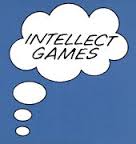
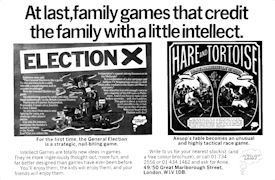

The Intellects (David Drakes, Roland Jarvis, Malcolm Gluck, Martyn Walsh)

GDP in 1970s with double-dip recession
(from The Guardian newspaper)
But 1976 sees the rot setting in. Inflation was still rampant, unemployment rising and interest rates soaring; and following
a major strike in the car-making industry the government felt obliged to seek loans from the International Monetary Fund.
In May 77 John Watson, Waddingtons Marketing Director, warns "The games business is not the booming industry that it
was in 1974". And in subsequent issues, members and associates of that industry reflected on its shortcomings in a
series of think-pieces under the series title "Platform".
The first of these, by Richard Guignard, founder of Omnia Games & Pastimes, argued that there were too many games on the market, most of them bad but cheap, the good ones few but pricey. Toy retailers were at fault for restricting their stock to a limited range of popular-sounding games, and manufacturers for dressing up potentially good games with character merchandising and irrelevant associations with popular television programmes.
In March 1978 his argument was expanded by Jack Jaffé in an article entitled "What's Wrong with the Games Industry?". He suggested some answers:
1. There is not enough reliable information about the industry because it is not represented by a dedicated trade organisation. The nearest approach to one is the British Toy Manufacturers' Association, which by its very title relegates games to children and families. "No one", he writes, "is promoting the concept of games playing as an acceptable and enjoyable adult leisure activity."
2. Welcome as Games & Puzzles's efforts are, it reaches only a limited number of games enthusiasts. What we need is a general consumer advertising campaign with a substantial budget. Most consumer-based industries spend some 10% of turnover on promotion and advertising, but the games industry spends only 3-4%, including trade advertising. That this is clearly inadequate is proved by the counter-example of Milton Bradley, who within 18 months of setting up their UK operation had taken an estimated 14% share of the UK market.
3. The games retail trade is badly structured. Games are stocked mainly by toy-shops, all-purpose multiples like W. H. Smith, department stores, and a few specialist games shops. All but the latter carry only a limited range and in hardly any will you find an assistant able to answer the questions "How do you play it; what's it all about?"
4. For an industry that relies on inventiveness, the games industry eschews innovation and prefers to publish games that have already proved their worth abroad. This safety-first approach stifles the creative output of the home market.
5. The industry has never attempted to bridge the large gap between the games manufacturers and the inventors. The latter work largely in the dark, with little or no knowledge of the former's intentions or policies. The inventor has no status: his name is all too rarely associated with his invention, and he receives inadequate reward for his creativity. The fact that his name is not given makes it difficult for him to build a reputation as an inventor.
Jaffé sought to solve these problems by founding SIGMA (the Society of Inventors of Games & Mathematical Attractions), hoping to bring together manufacturers, inventors, retailers and players to address all the issues he had identified. But of more than 60 companies invited to participate in a National Games Fair fewer that 20 replied, and only three joined SIGMA as corporate members.
In a later issue, Ian Livingstone (a co-founder of Games Workshop) also complains of inadequate retailing and criticises major games companies for failing to support local games clubs and conventions or to initiate any of their own.
Another major obstacle to the development of the 'serious' gaming industry in the UK, says Derek Carver, was that toy shops were "absolutely the wrong place to sell serious games". So why weren't they sold in bookshops, as in other countries? The answer was Purchase Tax, replaced in 1973 by VAT (value added tax). Books were tax-free, so booksellers who stocked games would have had to keep separate accounting records for them. Whereas modern tills can do this easily, those of the 1970s couldn't cope. Thus games were relegated to toy shops, where tax applied to the whole stock. To keep prices down, Graeme admits, Games Centre classified as many products as possible (especially Fantasy Games) as books!
Michael Gibson, of Gibsons Games, gave me his opinion that the games industry was adversely affected by a change in the nature of family activities partly associated with the expansion of television viewing. (Channel 4 started operating in 1982.) Graeme Levin blames the declining games market on the rapid rise of electronic and computer games, which were of little interest to himself and most of the team, and on the decreasing value of the magazine as an advertising tool for Games Centre. As this diminished in importance, the rising costs and effort involved became unsustainable.
It seems reasonable to ask, however, why changes of this sort, which were not specific to the United Kingdom, should not equally have affected other countries, notably Germany. On this point we may refer again to Werneck's paper of 2010:
"The fertile culture of game criticism disappeared virtually overnight. Games & Puzzles collapsed and most newspapers abandoned their game columns. Games published in Great Britain soon lost originality and quality, revealing the basic concept of business in a capitalist system [whereby] manufacturers strive for maximum output with minimum input. Competition was weak, and once caustic critics lost their publication platform the world of traditional family and board games shrank to a limited selection of rather poor products".
1978 saw the last issue published by Graeme Levin's Edu-Games company. Sold to Willow House Press, it became a quarterly. Resold to AHC Publications, it struggled on under its original title until summer 1981, when that title ceased with issue GP81. AHC then split it into two alternating bi-monthly publications, one called The Gamer, the other Top Puzzles. Chillingly, the word "computer" crept into its title, and it finally closed with issue 8 of The Gamer and Computer Gamer dated September-October 1982. Although it retained its regular contributors and consultants, it was clear that the life had gone out of it.
An attempt to revive the old Games & Puzzles titles was made by Paul Lamford in April 1994. It followed the original format fairly faithfully, and began to look quite promising. Unfortunately it lasted for only 16 months before collapsing under the weight of economic realities.
Graeme Levin had founded and published Games & Puzzles as a personal venture. In its heyday it attracted a reasonable revenue from advertising. But not enough - Graeme is reported to have said that only one issue ever recovered its costs. (He cannot now remember which one!) Also, it was his policy to restrict advertising to the games industry alone, so no income derived from non-game-related consumer products.
With the best will in the world, one can't help seeing Games & Puzzles in retrospect more as a glorified fanzine produced by amateur but knowledgeable enthusiasts than by professional but indifferent journalists. But it was wonderful while it lasted; and Graeme should be remembered with gratitude as an unsung visionary in the world of games.
Acknowledgements
Thanks to Graeme Levin, Eric Solomon, David Wells, Steve Jackson, Darryl Francis, Trevor Truran, Mike Atkinson, and Gyles Brandreth, for their encouragement and helpful reminiscences in the preparation of this article, also to Derek Carver, Michael Gibson and Tom Werneck for additional comments and contributions. Any errors and misjudgments are my own. - DP




